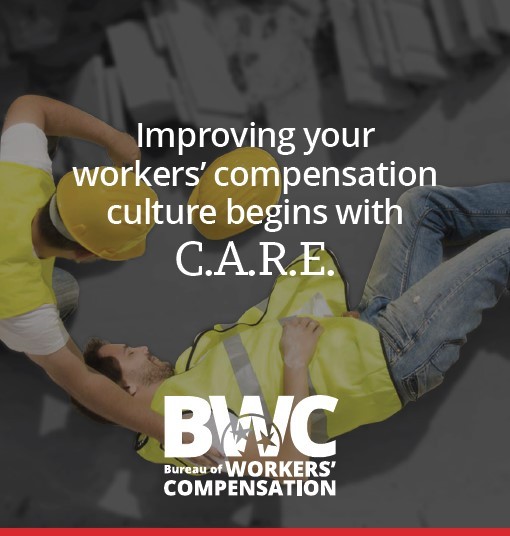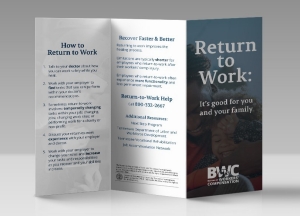Employer Responsibilities
Employer rights and responsibilities in a workers' compensation claimThe key to cutting unnecessary costs begins early in a work-related injury. Show your employees you C.A.R.E. and they will reward you with greater productivity and loyalty
Carry workers’ compensation insurance.
- Required for all construction employers
- Required for most other employers with 5 or more employees
Bright Idea: Even if you aren’t required to carry it,it may be business-savvy to secure coverage.
Accept all reports of injuries.
- Employers should not refuse to accept a report even if they doubt the injury occurred.
- When an injury is reported, employers should provide a Choice of Physicians form, also known as a medical panel.
Bright Idea: This panel must be provided on Form C-42. The employee should choose a physician, sign and return the form and be given a copy of the signed form.
Report all injuries to your carrier
within 24 hours of a reported injury.
Bright Idea: Notifying your carrier promptly allows them to begin to provide benefits or start their investigation, whichever is appropriate.
Earn the trust and cooperation of your employees.
Re-focus your program to “workers’ recovery.” Let injured employees know that you want to help them to recover and return to work as quickly as possible.
Bright Idea: If an employer considers an employee as disabled, the employee will view him- or herself as disabled, too.
Implement these Best Practices in workers’ compensation.
Become an advocate for your employee.
Reinforce your injured workers’ value to the company by staying in contact with them during their recovery.
Bright Idea: Help them make the initial contact with the insurance adjuster. Follow-up to ensure that the adjuster is providing all appropriate benefits timely.
Become a source of information.
- Give your employees a copy of the Beginner’s Guide to Tennessee Workers’ Compensation early in the process. It’s available here on our website.
- The Bureau’s Ombudsman Program can assist employees with questions if they are not represented by an attorney.
- Call 800-332-2667
- Email wc.ombudsman@tn.gov
Bright Idea: The Bureau’s website has a ton of information for injured employees and employers.
Lead by example.
Let injured employees know that you want to help them to recover and return to work as quickly as possible.
Display the Posting Notice.
Employers should inform their employees who they should notify if they are injured. This is done by displaying the Posting Notice.
Encourage quick reporting.
- Employees have 15 days to report an injury; but, encourage them to tell you sooner. Delays in reporting might delay recovery.
- If an injury is reported too late, the adjuster will take the steps to protect the employer’s rights. This might include denying the claim.
- Denying a claim that is filed late may lead to legal fees if challenged in court.
Bright Idea: To avoid potential unnecessary legal fees, report every claim of injury to your insurance carrier, even if it was reported late.
Investigate the claim; don’t deny it.
Employers don’t have the right to refuse to accept an employee’s report of an injury, even if they doubt the employee’s version of events—that’s the responsibility of the adjuster.
Bright Idea: Help your adjuster in their investigation by obtaining a written statement that provides the "who, what, when, where, and why" regarding the injury.
Consider participating in the Tennessee Drug Free Workplace Program.
This program is designed to foster safe worksites by promoting drug- and alcohol-free workplaces. There are multiple incentives for participating.
Bright Idea: Best of all—it’s free to join. And, it decreases the cost of insurance premiums. Visit our website to get started.
Consider multiple ways to help injured employees return to work.
Light duty, modified duties or even a new job entirely—working is good for our mind, body and soul. Some employers even allow injured workers to work at non-profits during their recovery.
Bright Idea: The Bureau’s Next Step Program has a fund designed to assist qualified injured workers to obtain training needed to re-enter the workforce.
Become a V.I.P. to help improve your workers' comp outcomes.
Value your employees.
Create a workplace culture based on trust and mutual aid. Let your employees know that you value them as much or more as you value your external customers and the goods and services you produce.
Bright Idea: Claims are easier to resolve in workplaces where employees have confidence that their employers are not putting their bottom line ahead of their employees.
Injury prevention is important.
Have management and employees work together to eliminate potential injuries before they occur:
- Form safety committees.
- Encourage reports of “near misses” without discipline.
- Stress workplace safety with posters, in new-hire orientations, and in newsletters.
Bright Idea: Safety Committees create additional people with safety responsibility with more eyes and ears on the worksite.
Prepare accurate job descriptions.
Most injured employees can return to some type of work. Be able to advise the treating physician exactly what is required in the injured worker’s normal job. If the doctor won’t allow that work to be done, find an alternative job for them. Allowing injured employees to return to work only if they can return to their normal duties might not benefit ether party.
Bright Idea: Turn your workers’ compensation program into a “workers’ recovery” program. Studies prove that the longer an injured worker stays off work, the less likely he/she is to ever return.
8 Steps employers should take when an injury is reported:
- Accept the report, and provide a panel of physicians on Form C-42.
- Provide a copy of the Beginner’s Guide to Tennessee Workers’ Compensation.
- Obtain a written statement from the injured employee.
- Complete your company’s internal Notice of Injury form, if you have one.
- Notify the carrier immediately.
- Work with the adjuster to investigate, if you have concerns about the claim.
- Prevent someone else from being injured by the same root cause.
- Work with injured workers and their treating physician to return them to work ASAP.
Start the RTW Conversation
Employers, adjusters, case managers and other work comp professionals are encouraged to use this brochure start the return-to-work conversation with injured workers. It identifies the impacts that a work injury have on their health, career, and family. It includes a five-step process to getting back into the workplace.

